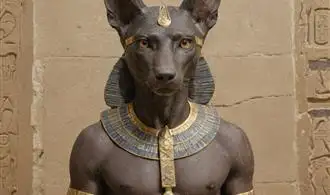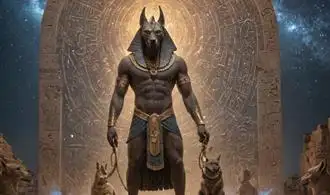
Anubis The Jackal Deity
Anubis, the ancient Egyptian deity with the distinctive jackal head, holds a profound significance in the pantheon of Egyptian mythology. As the god associated with mummification, the afterlife, and the protection of the dead, Anubis' iconography is deeply rooted in the rich tapestry of Egyptian culture. Understanding the symbolic nuances and representations of Anubis is crucial for those seeking to explore this captivating figure.
Jackal Symbolism: The jackal-headed appearance of Anubis holds a multifaceted symbolism. Jackals were often observed near ancient Egyptian burial sites, scavenging the dead, which led to their association with the realm of the afterlife. The jackal's keen senses and ability to navigate the liminal spaces between the living and the dead made it an apt representation for Anubis, the guardian of the necropolis and the embalming process.
Embalming and Mummification: Anubis' primary role was as the patron deity of the embalming and mummification rituals. He was believed to have been the inventor of the mummification process, guiding the embalmers in their sacred duty of preparing the deceased for the afterlife. Anubis' presence was essential during the embalming ceremonies, ensuring the proper preservation and protection of the body.
Psychopomp and Necropolis Guardian: Anubis was also known as the psychopomp, the guide who led the deceased souls to the underworld and the Hall of Judgement. In this capacity, Anubis was responsible for weighing the heart of the deceased against the feather of Ma'at, the goddess of truth and justice, to determine the worthiness of the individual for the afterlife.
Iconographic Representations: Anubis is commonly depicted with a jackal head, a human body, and various symbolic items. He is often shown holding a was scepter, a symbol of power and dominion, or the ankh, the symbol of life. Anubis may also be portrayed standing guard over a mummy or the canopic jars used to store the internal organs of the deceased during mummification.
Symbolism and Attributes of Anubis
Anubis, the jackal-headed god of ancient Egyptian mythology, holds a profound and multifaceted symbolic significance. As the lord of the dead and the guide of souls, Anubis is closely associated with the process of mummification and the afterlife. His iconography and attributes reveal the depth of his role in the intricate tapestry of Egyptian religious beliefs.
At the core of Anubis' symbolism is his connection to the process of mummification. As the god who presided over the embalming and preparation of the dead, Anubis ensured the preservation of the physical body, which was essential for the soul's continued existence in the afterlife. His jackal-like appearance, with its sharp features and piercing gaze, was believed to symbolize his keen senses and ability to navigate the realms of the dead.
Beyond the realm of mummification, Anubis held a pivotal role in the judgment of the deceased. In the famous weighing of the heart ceremony, Anubis would preside over the process, ensuring the integrity of the deceased's soul and their readiness to enter the afterlife. His presence at this critical juncture underscores his status as a guardian and protector of the dead, guiding them through the treacherous journey to the next world.
Anubis' attributes further enhance his symbolic significance. The color black, often associated with his jackal-like form, is believed to represent the fertile, life-giving soil of the Nile River, as well as the color of the decomposing body. This duality of life and death reinforces Anubis' role as a mediator between the realms of the living and the dead.
Additionally, Anubis is often depicted holding the was scepter, a symbol of power and divine authority, and the ankh, the hieroglyphic sign for life. These objects underscore Anubis' control over the cycle of life and death, as well as his ability to grant the deceased the opportunity for eternal existence in the afterlife.
Funerary Rituals and Anubis Iconography
The ancient Egyptian god Anubis, depicted with the head of a jackal, played a crucial role in the funerary rituals of the Nile civilization. As the god of embalming and the afterlife, Anubis was integral to the complex process of preparing the deceased for their journey to the afterlife. Understanding the iconography associated with Anubis can provide valuable insights into these ancient funerary practices.
One of the most iconic Anubis iconographies is the god's depiction as the "Guardian of the Scales." In this representation, Anubis is shown overseeing the weighing of the deceased's heart against the feather of Ma'at, the goddess of truth and justice. This ritual, known as the "Weighing of the Heart," was a crucial step in the afterlife judgment process, determining whether the individual was worthy of eternal life in the Duat (the Egyptian underworld).
Anubis was also associated with the embalming process, as evidenced by his portrayal in various funerary scenes. In these depictions, Anubis is often shown standing over the mummified body, ensuring the proper preservation and preparation of the deceased for their afterlife journey. The god's jackal-like head was believed to symbolize his role in guiding the soul of the dead, as the jackal was thought to have the ability to navigate the underworld.
Additionally, Anubis was closely linked to the ritual of the "Opening of the Mouth," a ceremony performed to restore the deceased's senses and faculties, allowing them to communicate and interact in the afterlife. In these rituals, Anubis would often be depicted alongside the deceased, using a ritual instrument to "open the mouth" and facilitate the transition to the afterworld.
The iconography of Anubis was not limited to funerary scenes alone. The god was also represented in various other contexts, such as temple decorations, amulets, and even personal possessions of the deceased. These diverse representations of Anubis reflect the multifaceted nature of his cult and the profound influence he had on ancient Egyptian beliefs and practices surrounding death and the afterlife.
Anubis in Contemporary Art and Iconography
Anubis, the ancient Egyptian god of the dead, has maintained a strong presence in contemporary art and popular culture. As a figure of immense symbolic importance, Anubis' iconography has evolved over time, yet certain elements remain consistent and essential to understanding his enduring significance. To avoid common pitfalls when depicting Anubis in art and design, it's crucial to grasp the nuances of his visual representation and the deeper meanings it conveys.
One of the most recognizable aspects of Anubis' iconography is the jackal or dog-like head. This canine feature is a direct reference to the animal believed to have guided the dead through the afterlife in ancient Egyptian mythology. However, it's important to note that Anubis is not a mere dog, but a distinct deity with his own unique attributes and responsibilities. Portraying Anubis simply as a generic canine figure can diminish the richness and complexity of his character.
Another key element of Anubis' iconography is the color black. As the god associated with mummification and the embalming process, Anubis' black skin is symbolic of the decomposition and regeneration that occurs in the afterlife. This color choice also links Anubis to the fertile black soil of the Nile River, which was seen as a source of life and renewal in ancient Egyptian cosmology. Incorporating the correct shades of black, rather than generic gray or dark tones, can help capture the deeper significance of this hue in Anubis' representation.
Anubis is often depicted holding or wearing the symbols of his role as the guardian of the dead. These may include the crook and flail, which were symbols of royal authority, or the ankh, a symbol of life. Accurately depicting these sacred objects and understanding their meaning can greatly enhance the authenticity and power of Anubis' iconography in contemporary art and design.
Beyond these core visual elements, Anubis' portrayal in modern contexts can also benefit from an exploration of his multifaceted roles and associations. As the god who presided over the crucial process of mummification, Anubis was seen as a protector of the dead, ensuring a successful transition to the afterlife. Acknowledging and incorporating these deeper narrative elements can imbue Anubis' representation with a sense of reverence and purpose, rather than mere aesthetic appeal.















